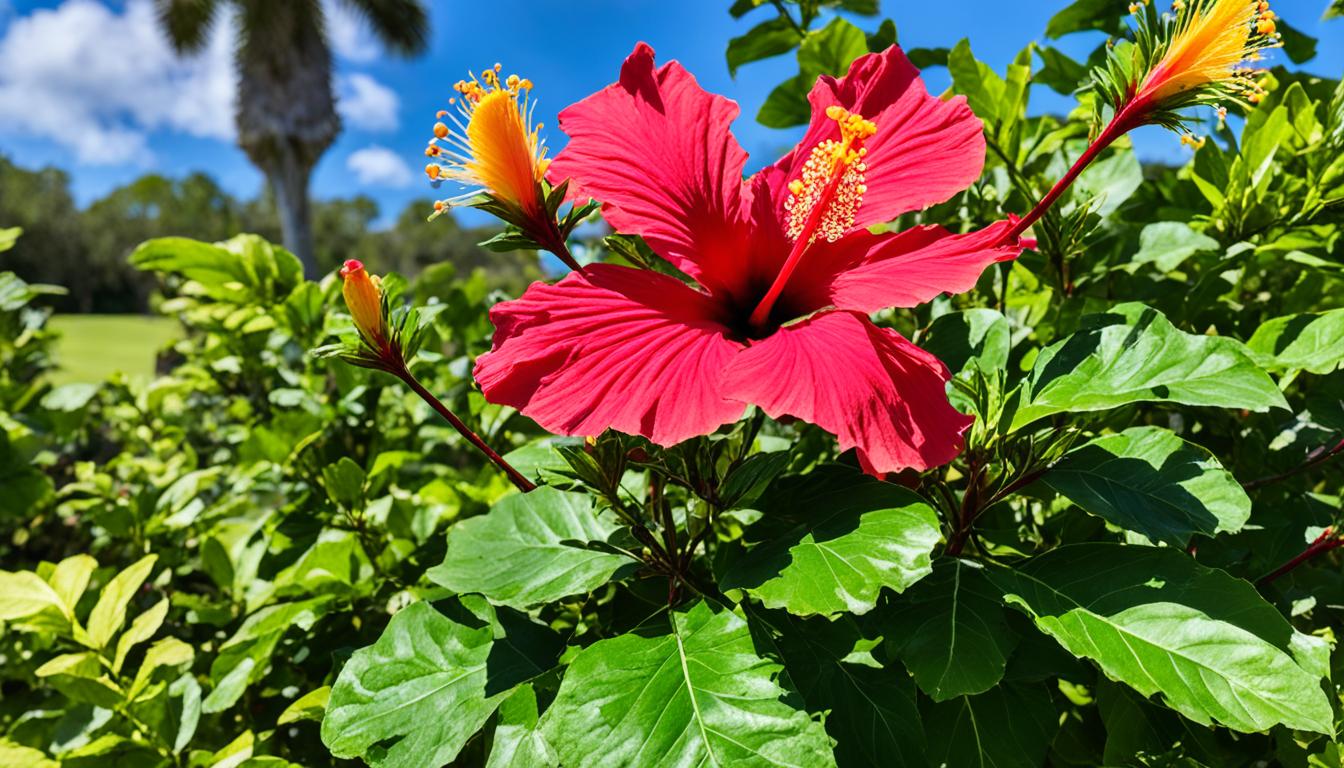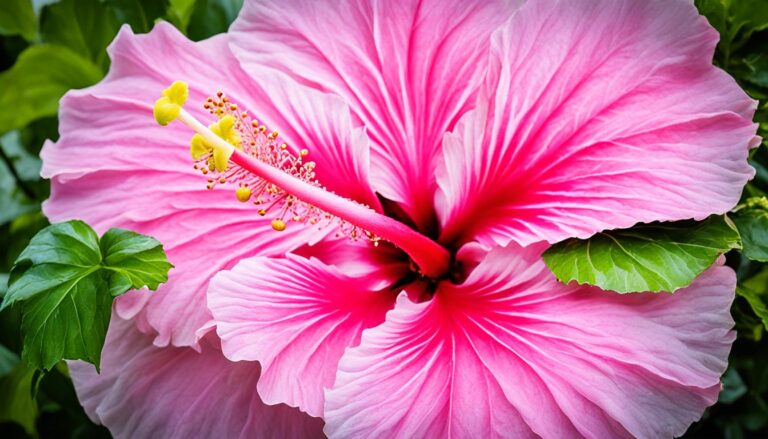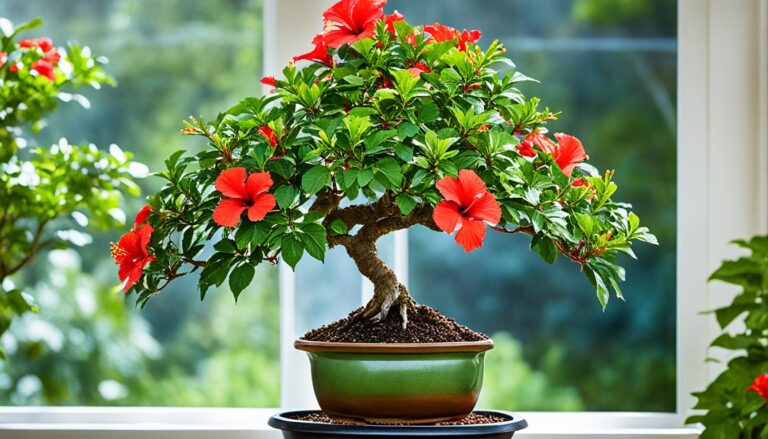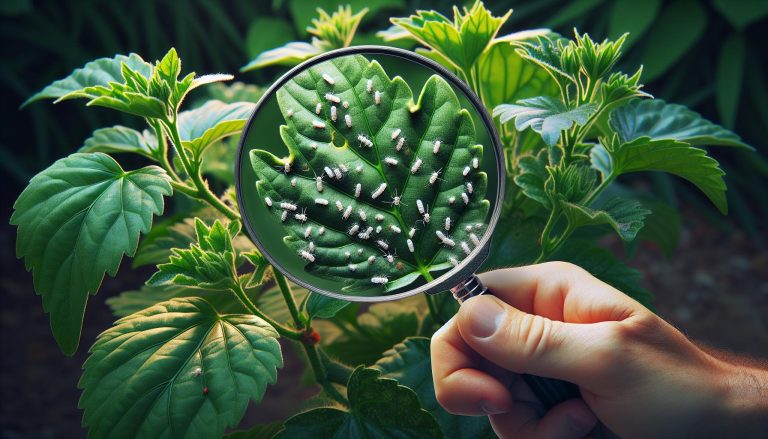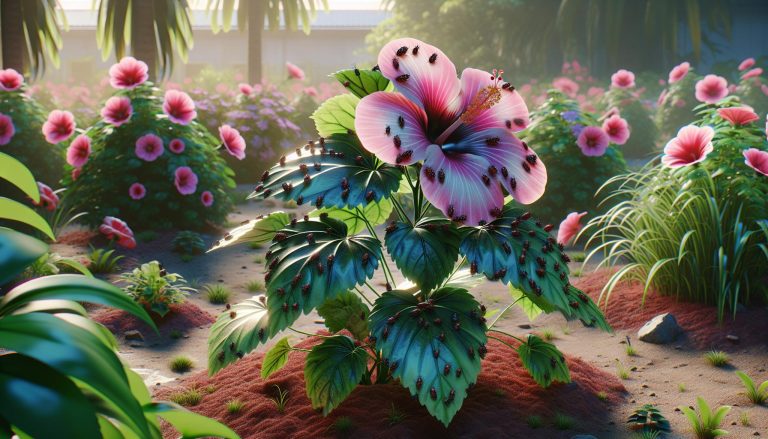Florida Hibiscus Blooming Season Guide
Are you captivated by the vibrant colors of hibiscus flowers? Do you dream of creating a tropical paradise in your own backyard? If you’re in Florida, you’re in luck! The Sunshine State provides the perfect climate for hibiscus plants to thrive and bloom year-round.
Picture yourself strolling through a lush garden, surrounded by an explosion of colors. The air is filled with the sweet fragrance of blooming hibiscus, and butterflies dance from flower to flower. You can’t help but smile as you soak in the beauty of these captivating blooms.
But when exactly do hibiscus plants bloom in Florida? The answer may surprise you. Unlike many other plants that have a specific blooming season, hibiscus in Florida have a long flowering period that lasts almost year-round in the southern part of the state. From stunning South Florida gardens to charming coastal landscapes, hibiscus flowers add a touch of tropical beauty wherever they grow.
Key Takeaways:
- Hibiscus plants in Florida bloom throughout the year, with a long flowering season that lasts nearly year-round in South Florida.
- The tropical hibiscus, commonly seen in garden centers and landscapes, originates from tropical regions of Asia.
- Hibiscus plants in Florida come in a wide range of colors and forms, attracting hummingbirds and butterflies.
- These versatile plants can be used for various landscaping purposes such as hedges, screens, or specimen plants.
- With proper care and attention to growing conditions, hibiscus plants can thrive in Florida’s climate and create a tropical and colorful floral display in the landscape.
Hibiscus Varieties in Florida
In Florida, the most commonly seen variety of hibiscus is the tropical hibiscus (Hibiscus rosa-sinensis). It is available in numerous cultivars with different flower colors and forms. These plants can be found in shades of red, pink, white, orange, yellow, and even violet and lavender. Some varieties have colorful foliage, adding to their appeal.
Hibiscus plants in Florida bloom on and off throughout the year, with each flower lasting only one day. However, a thriving plant will continuously produce new blooms, creating a vibrant display.
Here are some popular hibiscus varieties in Florida:
- Double Red – a vibrant red hibiscus with double flowers.
- Pink Beauty – a stunning pink hibiscus with large, ruffled flowers.
- White Wedding – a pure white hibiscus with a delicate, elegant charm.
- Orange Sunrise – a bright orange hibiscus with a tropical feel.
- Sunshine Yellow – a cheerful yellow hibiscus that brings sunshine to any garden.
- Purple Majesty – a deep purple hibiscus that adds a touch of royalty to landscapes.
- Lavender Dream – a delicate lavender hibiscus with a dreamy appeal.
With such a wide range of varieties available, hibiscus plants offer endless possibilities for creating stunning floral displays in Florida gardens.
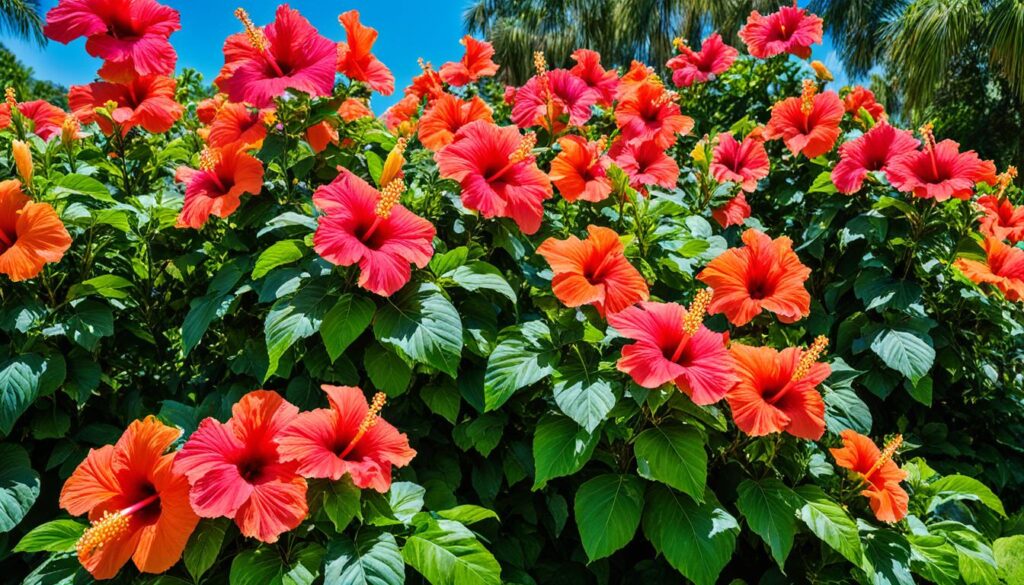
Native Hibiscus in Florida
Florida is blessed with approximately 35 species of native hibiscus, commonly known as rosemallows. These beautiful native hibiscus plants, such as Hibiscus coccineus, display a stunning array of flower colors ranging from dazzling white to vibrant pink, yellow, and red. Native hibiscus in Florida typically bloom from mid- to late summer, filling the landscape with their captivating colors and delightful fragrance.
Unlike their tropical counterparts, native hibiscus plants experience a specific flowering period in Florida, lending them a unique charm. Floridians eagerly anticipate the arrival of these native blooms, which can reach impressive heights of 4 to 8 feet, creating a stunning visual spectacle in gardens, parks, and natural landscapes.
While native hibiscus plants may go dormant during the winter months, their ability to withstand colder temperatures and somewhat drier soils sets them apart from their tropical relatives. This resilience allows them to thrive in various regions across the state, adding a touch of natural beauty to Florida’s diverse ecosystems.
Native Hibiscus Flower Colors
The native hibiscus species in Florida delight garden enthusiasts with their wide range of flower colors. From the delicate whites of Hibiscus grandiflorus to the vibrant reds of Hibiscus coccineus, these native varieties paint the landscapes with their distinct hues. Other native species, such as Hibiscus moscheutos and Hibiscus laevis, surprise onlookers with their captivating pink, yellow, and red blooms.
Native Hibiscus Species in Florida and Their Flower Colors
| Species | Flower Colors |
|---|---|
| Hibiscus grandiflorus | White |
| Hibiscus coccineus | Red |
| Hibiscus moscheutos | Pink, White, Red |
| Hibiscus laevis | Pink, White, Red, Yellow |
These exquisite native blooms add a touch of elegance and a pop of color to any landscape, attracting pollinators and creating a haven for butterflies and hummingbirds.
As you plan your garden or landscaping projects in Florida, consider incorporating these native hibiscus species to showcase the state’s rich botanical heritage.
Growing Conditions for Hibiscus in Florida
Hibiscus plants in Florida require specific growing conditions to thrive and produce vibrant blooms. By providing the right care, you can enjoy the beauty of these tropical flowers in your own garden. Here are some essential tips for successful hibiscus plant care in Florida:
Sunlight
Hibiscus plants in Florida thrive in full sun locations, where they can receive at least six hours of direct sunlight each day. However, they can also tolerate partial shade, as long as they still get enough sun. If planting in a partially shaded area, ensure they receive a minimum of six hours of direct sunlight to promote healthy growth and abundant blooming.
Soil
Well-drained soil is crucial for hibiscus plants in Florida. They prefer a soil that partially dries out between waterings to prevent root rot. You can improve soil drainage by adding organic matter such as compost or peat moss to the planting hole. Good drainage will help maintain the health of your hibiscus plant and prevent water-related issues.
Watering
Regular watering is essential for hibiscus plants, especially during the hot summer temperatures in Florida. They have high water needs and may require daily or even twice-daily watering to keep the soil consistently moist. However, be careful not to overwater, as this can lead to root rot. As a general rule, water deeply to saturate the root zone and allow the soil to dry out slightly between waterings.
Fertilization
Fertilizing hibiscus plants in Florida is necessary to ensure healthy growth and abundant blooming. Use a quality granular fertilizer specifically formulated for hibiscus plants. Apply the fertilizer three times a year, following the instructions on the package. Additionally, supplement with bone meal and liquid fertilizer to promote heavier blooming and overall plant health.
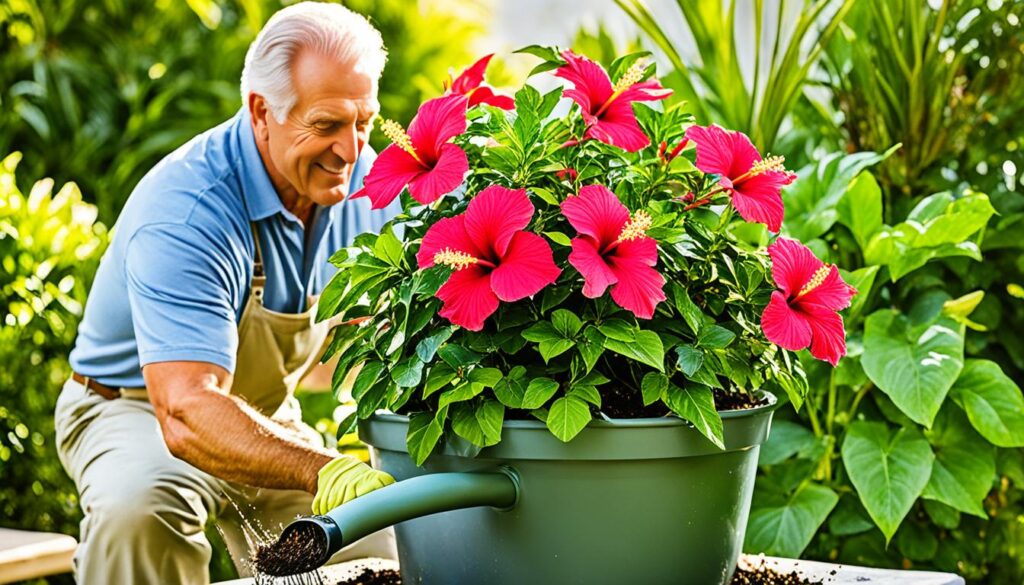
By providing the right growing conditions, you can cultivate beautiful and thriving hibiscus plants in Florida. Remember to choose a sunny location, ensure well-drained soil, water regularly, and fertilize as needed. With proper care, your hibiscus plants will reward you with stunning blooms that will brighten up your garden.
Hardy and Tropical Hibiscus Plants in Florida
Hibiscus plants in Florida offer a diverse range of options for gardeners, with both hardy and tropical varieties available. Understanding the differences between these two types can help you choose the right hibiscus plants for your garden.
Hardy Hibiscus
Hardy hibiscus plants are able to withstand cooler climates and are a great option for gardeners in areas where winter temperatures drop below freezing. These shrubs, also known as perennial hibiscus, die back during winter and then reemerge with vibrant growth in the spring.
Hardy hibiscus plants in Florida can bring bold and beautiful blooms to landscapes that experience colder temperatures. They are usually of the Hibiscus moscheutos species and are known for their large flowers and dramatic foliage. These native hibiscus species can be found in shades of white, pink, and red.
Tropical Hibiscus
Tropical hibiscus plants, on the other hand, thrive in Florida’s warm and humid climate. They are well-suited to planting in USDA hardiness zone 9 and areas further south. With their heat tolerance, tropical hibiscus plants can flourish in the Sunshine State and add a touch of the tropics to any garden.
The tropical hibiscus (Hibiscus rosa-sinensis) is the most commonly seen variety in Florida. These hibiscus plants are known for their showy, large, and colorful flowers. The tropical hibiscus comes in a wide range of colors, including vibrant reds, pinks, oranges, yellows, and even blues. They can even feature multicolored and variegated blooms.

In conclusion, whether you choose hardy or tropical hibiscus plants for your Florida garden, you can enjoy the beauty and versatility these plants bring. Hardy hibiscus can withstand colder temperatures, while tropical hibiscus thrives in Florida’s warm and tropical climate. Consider your specific growing conditions and preferences to select the hibiscus plants that will best suit your needs and create a vibrant and colorful display in your garden.
Pests and Diseases of Hibiscus in Florida
Hibiscus plants in Florida are not immune to pests and diseases. It’s essential for hibiscus enthusiasts to be vigilant and take preventive measures to ensure the health and vitality of their plants.
Pest Infestations:
Common pests that may afflict hibiscus plants in Florida include aphids, whiteflies, and mealybugs. These pests can cause damage by sucking sap from the plant, resulting in stunted growth, yellowing leaves, and distorted blooms.
To combat these pests, regular scouting is necessary. Inspect the undersides of leaves, buds, and stems for any signs of infestation. If pest activity is detected, it’s crucial to take immediate action. Insecticidal soaps or horticultural oils can effectively control these pests without harming the plant or beneficial insects.
When applying any insecticide, it’s important to carefully read the product labels and follow the instructions. Avoid using the pesticide malathion on hibiscus plants, as it may cause harm.
Common Diseases:
Hibiscus plants in Florida can also fall victim to various diseases, including fungal infections and leaf spot diseases. Fungal infections can present as leaf spots, powdery mildew, or root rot. Leaf spot diseases, such as Cercospora leaf spot and anthracnose, can cause brown or black spots on the leaves.
To minimize the risk of diseases, proper plant care and maintenance are essential. Ensure good watering practices, providing consistent moisture to the roots without overwatering. Proper air circulation around the plant helps reduce humidity, preventing the development and spread of fungal infections. Pruning any infected or dead plant material and avoiding overhead watering can also minimize the risk of diseases.
Additionally, removing fallen leaves and debris from around the plant can prevent fungal spores from overwintering in the soil, decreasing the chance of reinfection.
| Pests | Diseases |
|---|---|
| Aphids | Fungal Infections |
| Whiteflies | Leaf Spot Diseases |
| Mealybugs |
By remaining vigilant and implementing proper care practices, hibiscus enthusiasts can protect their plants from pests and diseases. Regular inspection, early detection, and prompt action can help maintain the health and beauty of these stunning flowering plants.
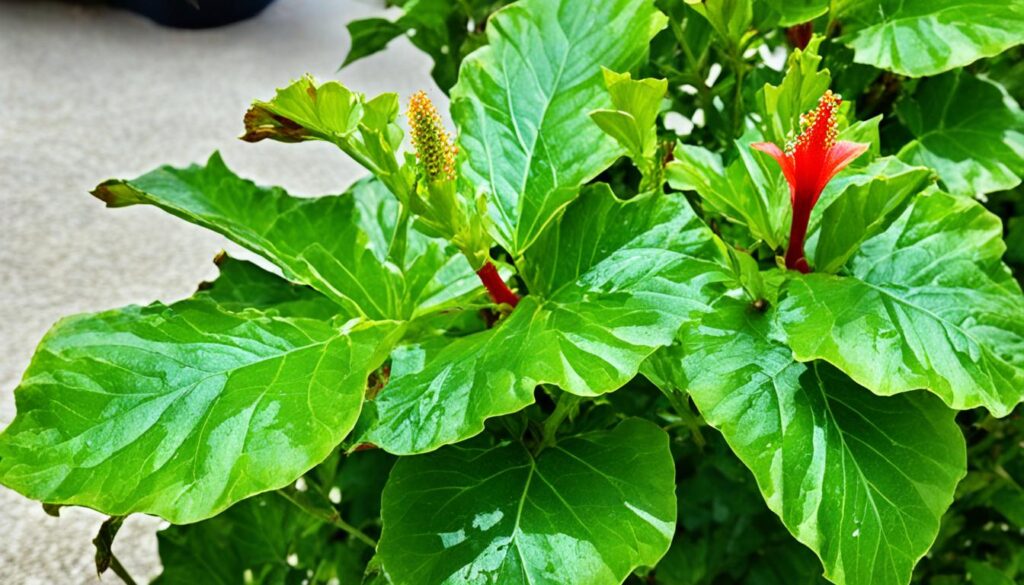
Medicinal Uses of Hibiscus Flowers
In addition to their ornamental value, hibiscus flowers have various therapeutic uses. Extracts made from hibiscus blooms are known for their potential benefits, including reducing blood pressure, detoxifying the body, and promoting skin healing.
Reduce blood pressure: Research suggests that consuming hibiscus flower extract may help lower blood pressure levels. The flower contains compounds that act as natural ACE inhibitors, which can help relax blood vessels and reduce hypertension.
Detoxify the body: Hibiscus flower tea is often consumed as a detoxifying beverage. It is believed to aid in flushing out toxins from the body, promoting overall health and well-being.
Promote skin healing: The properties of hibiscus flower extract make it beneficial for promoting skin healing. The flower extract is rich in antioxidants, which can help protect the skin from damage caused by free radicals. It also has anti-inflammatory properties that can soothe and calm irritated skin.
Hibiscus flower tea can be consumed to ease a sore throat or cough. The extracts from hibiscus flowers are also believed to increase metabolism and are sometimes used to aid in weight loss. Furthermore, hibiscus is used as an ingredient in shampoos and conditioners due to its beneficial properties for hair health.
Whether enjoyed as a cup of tea or incorporated into skincare products, hibiscus flowers offer a natural and holistic approach to health and wellness. The therapeutic uses of hibiscus flowers make them a valuable addition to any lifestyle.
Landscape Uses for Hibiscus in Florida
Hibiscus plants in Florida offer endless possibilities for enhancing your landscape. Whether you’re looking to create a stunning focal point, add a colorful background plant, or create an informal hedge, hibiscus can fulfill all your landscaping needs. These versatile plants can be incorporated into garden beds or grown in containers, allowing for flexibility and creativity in design.
One of the standout features of hibiscus plants is their vibrant blooms, which add a pop of color to any area of your landscape. The flowers not only beautify your outdoor space but also attract beneficial pollinators such as bees, butterflies, and hummingbirds, creating a lively and dynamic ecosystem in your garden.
When it comes to companion planting with hibiscus in Florida, there are several popular choices that complement these stunning flowers. Consider planting hibiscus alongside gold mound, croton, oleander, or plumbago to create a visually appealing and harmonious display. These companion plants will enhance the overall aesthetic and provide additional textures and colors to your landscape.
Landscaping Ideas for Hibiscus in Florida
Here are a few landscaping ideas to inspire you in incorporating hibiscus into your Florida garden:
- Create a focal point: Plant a vibrant hibiscus variety as a focal point in your yard or garden. Choose a location where it can stand out and draw attention, such as near your entrance or in the center of a flowerbed.
- Background plant: Use hibiscus as a beautiful background plant to add depth and visual interest to your landscape design. Plant taller varieties behind smaller shrubs or flowers to create a layered effect.
- Informal hedges: Plant hibiscus in a row to create an informal hedge. This can serve as a natural boundary or provide privacy in your outdoor space. Trim the hedges regularly to maintain their shape and promote healthy growth.
- Container gardening: Grow hibiscus in containers for added versatility. Place them on your patio, balcony, or porch to create a vibrant and colorful display. Mix different hibiscus varieties and companion plants to add variety and visual appeal.
With their stunning blooms and versatile nature, hibiscus plants in Florida can transform your landscape into a tropical oasis. Get creative with your planting arrangements and enjoy the beauty these plants bring to your outdoor space.
Tips for Planting and Growing Hibiscus in Florida
When it comes to planting and growing hibiscus in Florida, a few key tips can help you ensure success. Follow these guidelines to cultivate thriving hibiscus plants in the Sunshine State:
Choose a Sunny Location
Flourishing hibiscus plants in Florida require abundant sunlight. Select a spot in your garden that receives at least six hours of direct sunlight each day. This will promote optimal growth and vibrant blooming.
Ensure Well-Drained Soil
Hibiscus plants thrive in well-drained soil. Prior to planting, prepare the soil by adding topsoil or organic peat humus. Mix in composted cow manure to enrich the soil and improve its quality. This will provide the necessary nutrients and drainage for your hibiscus plants to thrive.
Regular Pruning
Regular pruning is essential for shaping and maintaining the size of your hibiscus plants in Florida. Trim away any dead wood or overgrown branches to encourage new growth and maintain a healthy shape. Pruning can be done throughout the year, but it is best to avoid significant pruning during the peak blooming season.
Proper Watering
Proper watering is crucial for the health of hibiscus plants in Florida. While regular watering is necessary, it’s important to strike a balance and avoid overwatering or underwatering. Monitor the moisture level of the soil and adjust your watering schedule accordingly. Hibiscus plants require consistent moisture, particularly during hot summer temperatures.
Fertilize Regularly
To maximize blooming, fertilize your hibiscus plants in Florida three times a year. Apply a quality granular fertilizer specifically formulated for flowering plants. Additionally, supplement the fertilizer with bone meal and liquid fertilizer during the blooming season. This will provide the necessary nutrients for healthy growth and prolific flowering.
| Planting Tips | Care Tips |
|---|---|
|
|
Conclusion
Hibiscus plants are a delightful addition to the Florida landscape, providing year-round beauty with their colorful and vibrant blooms. From spring through fall, these magnificent flowers grace gardens and landscapes, attracting pollinators and adding a touch of tropical allure.
With proper care and attention to growing conditions, hibiscus plants can thrive in Florida’s climate. Regular watering, well-drained soil, and adequate sunlight are key factors for successful hibiscus cultivation. These resilient plants are versatile and can be used as focal points, in garden beds, or even in containers to create a stunning floral display.
Whether it is the best time for hibiscus to bloom in Florida or the height of the hibiscus blooming season, these plants never fail to captivate. So, if you’re looking to infuse your landscape with color and beauty, consider adding hibiscus plants to your garden and enjoy the tropical paradise they bring to your outdoor space.

